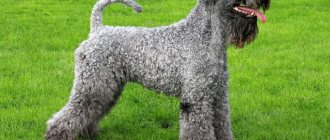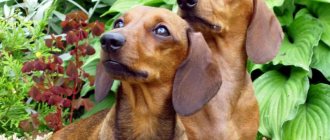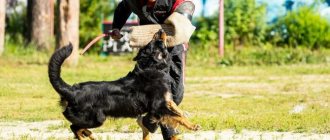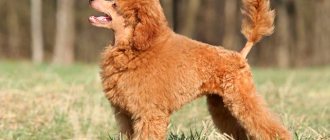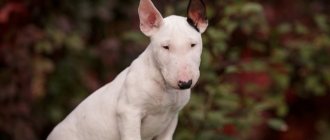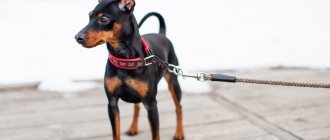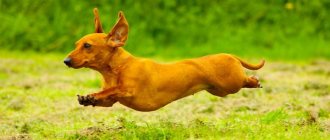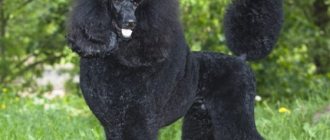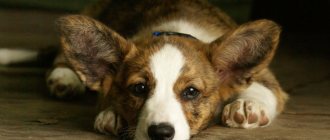Story
Yorkshire Terriers have gained popularity among people all over the world, but the origin of the breed is very mysterious. Scientists agree that the ancestors of the current indoor dog were hunting terriers of a wide variety of breeds that lived in the British Isles several centuries ago. Terriers were used by poor people, particularly coal miners, to hunt small rodents.
Similar to modern representatives of the Yorkie breed, they appeared at the end of the 19th century in Yorkshire. After persistent selection work, a terrier of the desired size and weight with a long, silky coat was finally born. The dog's name was Ben, he won more than 70 prizes and left a large offspring, becoming the founder of the breed.
In 1886, Yorkies were officially recognized and entered into the stud book by the most influential kennel club in the world - the English. Since that time, the breed has become popular.
This is interesting: Life expectancy of Yorkies
Varieties of Yorkshire Terriers
The ancestors of Yorkies appeared in England in the 18th century. Initially, they were not a decorative breed, but working dogs, which were used in mines to detect the accumulation of gases, to fight mice and rats in homes and factories, and to hunt small rodents and birds.
Over time, members of the royal family and court nobility drew attention to them; the kids settled in palaces, emphasizing the status of the owner.
Miniature doggie
By the end of the 19th century, as a result of hybrid crossings of small dogs of different breeds, the dwarf Yorkshire terrier with long silky golden-blue hair appeared - an ideal companion dog with intelligence, a balanced character and a sociable disposition.
Interest in the breed has not waned for more than two centuries. Yorkies have repeatedly been included in the Guinness Book of Records as the smallest dogs on Earth, for example, a terrier from Thailand weighed 481 grams with a height of 12 cm, and a baby from the British city of Blackburn had a height of 6.3 cm and weighed only 113 grams.
Thanks to modern breeding work, breed varieties have appeared that differ from the recognized standard:
- weighing micro Yorkshire terrier (up to 1.5 kg), mini York (1.4 - 2 kg);
- color - black and white beavers, chocolate and white biros, choco-yorkies of all shades of brown, golden goldusts, golden-red Russian salon mermaids;
- structure of the skull - the most popular is the baby face York (baby face - child's face) - the eternal puppy. This expression of the muzzle is given by large, wide eyes and a slightly upturned nose. The shape of the head is most often inherited from the manufacturer.
Attention! From the point of view of the baby face standard, micro and mini are a deviation from the norm. In the breed’s homeland, breeders usually do not breed such dogs, since they do not improve the breed’s qualities in any way. These miniature representatives of Yorkies do not participate in canine exhibitions, where the characteristic parameters of the breed are a priority. Girls, due to their critical body weight and fragile bones, cannot bear offspring and give birth on their own. They undergo a caesarean section, after which they do not live long. You take a pet solely “for the soul.”
Differences
Yorkies mini and supermini are different from standard individuals in the following respects:
- Miniature dogs have a slightly shortened muzzle and an upturned nose. They are also called “baby faces” in another way.
- Dwarf Yorkshire Terriers have a balanced temperament and calm character; the dogs do not have a hunting instinct.
- It is dangerous for small Yorkies to run and jump: in these species the fontanelle does not heal, and their bones remain fragile even in adulthood.
- Dwarf Yorkies are problematic to breed. Dimensions do not allow females to bear and give birth to puppies. In order for offspring with characteristic characteristics to appear, a dwarf boy is mated with a girl weighing at least 2 kg.
- They cannot be exhibited at shows: experts evaluate the breed according to a general standard.
- The very small species is intolerant and requires constant care.
Types of Yorkies
The Yorkshire Terrier breed standard does not include a division by size, but in life it is customary to classify dogs into the following three sizes:
- Standard. Dogs weighing from 2.5 to 3.2 kg, participating in breeding and exhibitions.
- Yorkshire Terrier mini. The weight of the animals is from 1.6 to 2.2 kg. They do not participate in exhibitions; only males are suitable for breeding. They are family favorites and excellent companions. They get sick somewhat more often than representatives of the standard.
- Supermini or micro. Dogs weighing no more than 1.5 kg. The Yorkshire Terrier Super Mini is not used for breeding and does not appear at shows. Dogs are generally prone to hypoglycemia and injury because they are unable to jump off a chair or sofa on their own. Their life expectancy is very short due to the peculiarities of metabolic processes and susceptibility to various canine diseases.
In addition, dog breeders especially appreciate the mini baby-face Yorkshire Terrier. These are puppies with large round eyes on short muzzles and “gnomes” - dwarf dogs with an open fontanel and large bulging eyes.
Characteristics of Yorkies
The description of the breed is determined by the International Canine Federation. According to standards, the body weight of a Yorkshire Terrier should not be more than 3.1 kg. The minimum weight and size of a dog are not regulated. Yorkie's height doesn't matter either.
Useful article: Rules for feeding Yorkies at home
The remaining characteristics of the Yorkshire Terrier are presented in the table:
| Part of the body | Description |
| Head | Skull small, flat |
| Muzzle | Small, short |
| Eyes | Dark, non-convex |
| Jaws | Even bite, the upper incisors sit tightly in front of the lower teeth |
| Ears | Wide apart, triangular |
| Undercoat | Absent |
| Limbs | Straight, densely covered with hair |
| Frame | Compact, short back |
| Tail | To be docked to the middle |
Good to know: 3 ways to fit the ears of a Yorkshire Terrier
Appearance
The popularity of Yorkshire Terriers is due to their toy appearance and large, button-like eyes. In general terms, the description of the breed looks like this:
- height – 20-25 cm, weight – up to 2 kg;
- rectangular, straight silhouette with a shortened lumbar region;
- the body is dense, of average fatness;
- paws are straight, with rounded feet;
- long, pleasant to the touch, silky coat;
- miniature head with a slightly narrowed muzzle;
- black nose;
- dark brown, oval-shaped eyes;
- small, graceful ears, most often erect;
- a scissor bite with a row of small, sharp teeth.
The above characteristics are typical for the breed standard, however, there are acceptable deviations that give the little ones a defenseless puppy-like appearance. These include the so-called baby face. It is expressed in a combination of a less prominent muzzle, a slight snub nose, and childishly naive eyes. Baby face is determined by the distance from the nose to the forehead. If it is less than 1.5 fingers long, then this is just such a puppy. For a more accurate determination, it is worth consulting with a specialist.
Unfortunately, dogs pay the price for their doll-like appearance:
- enlarged eyes are accompanied by narrowing of the tear ducts and the development of dangerous infections;
- due to the convex shape of the eyes, they are susceptible to injury and damage;
- the altered shape of the skull provokes early tooth loss and gum disease.
Yorkies with this trait need extra attention and regular visits to the veterinarian.
Another toy that comes to life is the mini Biewer Yorkie. This is a beautiful animal with a regular silhouette, the dimensions of which vary from super-mini: height - up to 27 cm, weight - 2-3.5 kg. The Biewer's coat is straight, thick and flowing. This dog breed comes in a variety of colors:
- there are three colors on the head at once: black, white, gold or gold, blue, white;
- body – in black and white and white and blue tones;
- the paws, belly and chest are painted exclusively white.
Their luxurious coat requires careful care. If the owners do not intend to take their pet to exhibitions, then it is better to shorten it so as not to cause discomfort.
Color
Mini Yorkie puppies have a dark coat. As the dog grows older, the color of the dog changes: the body and tail become grayish-steel in color, the paws and head acquire a brownish-golden hue. The tail is usually darker than the body. The fur on the chest is colored in soft platinum shades, through which golden areas break through.
Character and appearance of the terrier
Yorkshire terriers have preserved the features of their distant hunting ancestors. Yorkies are the same brave, curious, tireless dogs. They are characterized by sociability: Yorkshires are ready to spend 24 hours a day with their owner, become attached to him, and are able to sense a person’s psychological state and adapt. Dogs are friendly to strangers and get along with children.
Other personality traits of Yorkies are also attractive. The terrier loves to walk and will become a constant companion for the owner, who will definitely not get bored thanks to the dog’s playfulness and sociability.
Character and intelligence
Yorkshire terriers have deservedly earned the title of the most affectionate and gentle pets. Thanks to this, they easily get along with other animals, people, and children. The dogs are very energetic, active, and have an interested, inquisitive disposition.
The dwarf Yorkie does not like long walks and wants to be in constant motion. If this is not done, the dog becomes capricious, nervous, and irritable.
Yorkshire terriers are non-aggressive breeds, but even such a small dog can stand up for itself and its owner if necessary. Yorkies often chase small birds, butterflies, and insects. This is due to their hunting instinct. Yorkshire Terriers are very smart and quick-witted .
Attitude towards children and others
Mini Yorkshire Terriers get along well with children of different ages, but it is not recommended to purchase a dog when there is a baby in the house. Otherwise, there is a chance that the baby will harm the small animal while playing.
Animals do not tolerate separation from their owner and loneliness very well; they become very attached to children and their owners. It is worth noting that Mini Yorkies experience almost physical suffering when separated, but are less intrusive than other dogs.
Training
Mini Yorkies are perfectly amenable to training and learning commands, even if you devote a minimum of time to this, dogs can quickly remember all commands and remember them for a long time. They are receptive, so even children can train the animal.
It is recommended to walk, train and exercise the dog at least 2 times a day, at least for 1 hour. If you have a dacha, a country house, or plan to go to a camp site, you can take your Yorkie with you so that he can frolic to his heart’s content.
If the dog is not physically stressed, it begins to chew furniture, wallpaper, and clothes in order to throw out the accumulated energy.
Education and training
Yorkies are easy to train, but to develop discipline, the owner needs to know about their age characteristics. Dog trainers give recommendations for training dogs for each developmental period.
This is interesting: Basic rules for training York Terriers
One to two months
Usually at this age, breeders give puppies to families. When Yorkies are 1 month old, dogs can already understand simple commands. The sooner they begin to accustom the puppy to exemplary behavior, the more effective the educational process will be.
Raising a Yorkie depends on whether the dog can respond to its name. The puppy's name should be sonorous and should be pronounced constantly - during walks, feeding, and in any other situations.
Expert opinion
Anna Abramenko
An avid dog lover. Experience in veterinary medicine since 2009.
Ask a Question
The very first thing a Yorkie owner should do is prepare a comfortable mat or bedding for the dog and a special absorbent diaper.
Toilet training a Yorkie:
- it is necessary to remove carpets and paths for a while so that the puppy, not accustomed to cleanliness and order, does not go to the toilet on them;
- the diaper should be placed next to the Yorkie's rug or bedding;
- At first, you should watch the puppy very closely. When he is ready to defecate, the dog is immediately carefully placed in the toilet seat;
- if a puddle appears in the wrong place, it is lightly dipped in a diaper intended for use, which must be put back.
Read more about the training process here.
Expert opinion
Anna Abramenko
An avid dog lover. Experience in veterinary medicine since 2009.
Ask a Question
To accustom the dog to a resting place, the Yorkie is placed in the designated place, given a treat, and the appropriate command is uttered. The exercise with the puppy should be methodically repeated at least three times a day.
Also, a two-month-old Yorkie is already being taught the commands “no”, “fu”, “lie down” and “sit”. They must be pronounced loudly and clearly, without diluting them with unnecessary words. The puppy is given a treat for obedience.
In addition, a Yorkshire terrier at this age can be taught the seemingly complex “come to me” command. To do this, take a bowl of food, call the pet by name and say a command in a loud voice. The puppy will immediately run to the smell of food, the owner can only praise him. This lesson is taught every time the Yorkie is fed.
Compliance with the daily routine is important for the discipline of a new family member. You should never give your Yorkie food from the table. Otherwise, the pet will steal food. It is almost impossible to wean a dog from this bad habit.
Two to three months
When the puppy grows up, he will begin to be active. Your Yorkie's behavior will not always be appropriate. It is necessary to set the limits of what is permitted for the puppy.
For example:
- A dog can only play with its own toys, but not with its owner’s things.
- Under any circumstances, a Yorkie is prohibited from biting people, chewing furniture, cords, and clothing.
During this period, you already need to purchase equipment for walking. But you need to accustom your Yorkie to a collar at home. Only when the dog gets used to the presence of a foreign object on the neck can you attach a leash of the appropriate length (7-9 m) to the collar and go for a walk.
First, you need to follow the puppy everywhere, and only gradually begin to pull on the leash while playing. This way the dog will learn to follow its owner. You also need to make sure that the Yorkie does not move further than 1.5 meters.
In an uncrowded place, in nature, you can remove the leash and let the puppy frolic. Before doing this, you should say the command “walk”.
Three to five months
At this age, it is necessary to consolidate and hone the lessons learned, and also teach the Yorkie puppy to refuse food offered by strangers.
This is done as follows. The owner must sit the terrier next to him and put a collar and leash on him. Then a helper, not a family member, will offer the Yorkie a piece of the treat.
When the puppy tries to take food, you must give a strict command “no” (“fu”) and sharply pull the leash. Then the scenario is repeated. If the Yorkie tries to eat the treat again, the owner makes a sharper jerk. After several times, the dog will remember that you cannot take food from a stranger.
Six to ten months
A puppy of this age is almost an adult; he can already be taught the more difficult commands “give” and “fetch”.
The first request is of considerable importance in everyday life. Dogs tend to put inappropriate, dirty objects in their mouths, and you need to keep this under control.
When a Yorkie grabs an object with its teeth, the command “fu” is voiced. Then, firmly, but without allowing any rude movements, they take the thing out of the mouth and again say “no!” After this, you need to properly praise the puppy and treat him with his favorite treat. The manipulation is carried out several times during one walk.
Next, you can start teaching your pet the “fetch” command. York is seated next to him and a stick is waved in front of his nose, as if teasing him. The terrier will want to grab it, and at this moment, they allow you to take away the object being fetched, and give the command “fetch”. If your grip is weak, you can pull the stick a little, and then the dog will grip it tighter.
At the end, the puppy is fed and the training continues:
- the owner throws away the stick and again pronounces the order “fetch”;
- then repeats the command “give.”
You need to use different items to train your Yorkie.
General rules of education and training
Physical punishment of Yorkshire Terriers is prohibited. If you want to show the puppy dissatisfaction with his behavior, it is permissible to splash water on him or sharply clap your hands. In addition to these measures, it is best to scold the puppy in a stern, menacing voice.
A dog can be punished for unwanted actions only at the moment of commission. Raising a Yorkie should be based on the pet's trust in the owner and their mutual understanding, and not on cruelty.
And it’s worth training your pet only when he’s alert and well-fed:
- The Yorkie should not be allowed to take the leading position even for a short time. A person should always dominate.
- You need to praise and reward your pet with treats for success.
- Terrier training should be done every day if possible.
- It is advisable for the owner to show a sense of proportion and take care of his pet.
Care and maintenance of the Yorkshire Terrier
Yorkshire Terrier is a decorative breed , so it is necessary to take special care of the dog and follow all the rules of keeping.
Wool
To prevent tangles from forming in your Yorkie's coat, your pet should be combed every day with a wide-tooth comb, then with a soft-bristled brush. The terrier needs to be cut every 3 months (either on your own or at a dog hairdresser).
Wash your pet once every 10-14 days using shampoo and conditioner.
Basic rules for bathing a Yorkie:
- Place a rubber mat in the sink or bathtub.
- Cotton swabs are inserted into the animal's ears.
- Lather the shampoo, mix with water, lather the dog’s fur and rinse, repeating the procedure 2 times. Then apply the balm.
- After bathing, the Yorkie is wrapped in a terry towel, dried with a hairdryer, and combed. You can lubricate the wool with cosmetic oil.
Ears and eyes
The terrier's ears should be inspected constantly, and they should be cleaned 2 times a week with a cotton swab dipped in a special solution. Eye hygiene is also carried out with lotion and wet wipes.
Teeth
To avoid unpleasant consequences, Yorkies have their teeth brushed with a specialized paste 2-3 times a week. And every six months the dog is examined at a veterinary dentistry.
Claws
A Yorkie gets a manicure and pedicure twice a month using wire cutters or nail clippers. The procedure must be carried out extremely carefully.
Cloth
In cold or rainy weather, your Yorkie will need special clothing - insulated overalls or a sweater. To protect your dog's paws, you can purchase boots.
What and how to feed
Puppies at the age of 3 months are fed 5 times a day. As you get older, the number of meals is reduced to 2 times a day. To avoid digestive problems, it is important not to overfeed your pets. The serving size is determined by the dog's weight: for every half a kilo of weight there should be one spoon of food.
At first, you should maintain the puppy’s usual diet; experiments are best left for later. You need to follow the breeder's recommendations for at least a couple of weeks. Then you can gradually introduce other types of food, carefully observing the absence of an allergic reaction.
When purchasing ready-made dog food, you should choose premium brands. It is better to give preference to specially balanced food for Yorkshire terriers. It usually consists of half meat products. The food granules are covered with a hard shell, which helps remove tartar from the surface of the teeth. Food must be selected taking into account the age and health status of the pet.
When feeding natural food, preference should be given to fresh dietary products. Most of the diet should consist of proteins. Fermented milk products are better for puppies, and meat or offal for adult dogs. It is also necessary to feed your Yorkies with cereals, vegetables and fruits, and add vitamins to the diet. It is recommended to give sea fish fillet no more than once a week.
Feeding the puppy natural products
Important! When preparing your dog's food yourself, you should not add any seasonings.
What not to give
To keep your pet healthy, you should avoid the following ingredients:
- fat meat;
- bones;
- oatmeal and pearl barley;
- smoked foods, pickles;
- cabbage, potatoes.
Note! When mixing ready-made food with natural products, your pet may experience digestive problems.
Vaccination
Vaccinations for dogs are given according to the following schedule:
| Vaccination | Age in months |
| From hepatitis and enteritis | 1,5 |
| From the plague | 2 |
| Repeat vaccinations | 3 |
| Revaccination (after changing teeth) | 6 |
| For rabies | 8 |
2-3 weeks before vaccination, the puppy must be rid of worms. Adults are dewormed every six months. You also need to promptly treat your Yorkie's fur against fleas and ticks.
So that the owner knows what the normal body weight of his pet should be, veterinarians have developed a table of average weight by month.
This is interesting: 10 best holistic foods for small breed dogs
Yorkies have a very sensitive digestive system. In order for your dog to always be healthy and in a good mood, you need to choose a balanced diet for him.
Allowed products for Yorkies:
- boiled meat (chicken, turkey, rabbit, beef);
- offal (udder, heart, lungs, liver, offal);
- lean sea fish;
- porridge (rice, buckwheat, millet);
- dairy products;
- boiled vegetables (carrots, cauliflower, pumpkin, broccoli, zucchini);
- greenery;
- eggs.
Expert opinion
Anna Abramenko
An avid dog lover. Experience in veterinary medicine since 2009.
Ask a Question
The Yorkshire Terrier's diet should consist of 50% protein foods, 25% carbohydrates and vegetables.
Prohibited foods for Yorkies:
- sweets;
- salt and spices;
- bread, pasta;
- fatty meat, fish;
- bones;
- onions and green onions;
- mushrooms;
- sausages;
- milk.
The volume of the dog's portions should be proportional to the energy expended. You cannot make your pet become obese or overfeed your Yorkie. It is also worth paying attention to the terrier's nutritional discipline. As for food, the following brands are popular: Orijen, Purina Pro Plan, Mera Dog, Hills's, Acana, ROYAL CANIN.
Life expectancy and health
With proper care, standard Yorkies live up to 16 years, more specific varieties are somewhat shorter.
Most often, Yorkshire terriers suffer from diseases of the following systems and organs:
- hearing organs (due to improper care or hypothermia);
- oral cavity;
- gastrointestinal tract;
- musculoskeletal system (injuries from falls).
In addition to the diseases characteristic of all Yorkies, the following troubles exist for baby faces: conjunctivitis, eyeball injuries, early tooth loss, snoring and grunting.
Note! Females are not able to safely bear offspring and give birth on their own. They undergo a caesarean section, after which the dogs do not live long.
The procedure for vaccinations:
- The first vaccine is given at 2 months, revaccination - after 2 weeks;
- the second vaccination is given after changing teeth without the need for revaccination;
- third vaccination at 12 months;
- then the pet is vaccinated once every year.
1-2 weeks before vaccination, the puppy should be given an anthelmintic. Before vaccinating, you should make sure that the dog is absolutely healthy. If any abnormalities are suspected, vaccination should be postponed for several days.
Important! After the vaccine is administered, caution must be exercised for a week: the pet should not go for walks or have contact with other dogs.
Advantages and disadvantages
Advantages of the Yorkshire Terrier:
- Yorkies can be kept even in small apartments;
- the breed is friendly and non-aggressive;
- Terriers can get along with children and other pets;
- Yorkies are smart and quick-witted;
- dogs are characterized by cleanliness;
- Representatives of this breed do not shed and do not cause allergies.
Minuses:
- the terrier has a weak body and is prone to various diseases;
- a female Yorkie must be sterilized or males not allowed near her;
- Yorkshire Terriers are prone to injury;
- Dogs need to be carefully looked after and given a lot of time;
- This is a rather expensive breed.
Mini Yorkies in Russia
The first mini Yorkshire terrier in Russia appeared in 1971 with the legendary Soviet ballet star Olga Vasilievna Lepeshinskaya, who received this dog as a gift from fans. Until the 90s of the last century, single representatives of this breed appeared in different cities of our country, of which there were only ten at that time.
Only in 1991, animals of this breed were brought to Mytishchi from France, England and Spain, and the first nursery was founded. The Mini Yorkshire Terrier has become a popular miniature breed. The first Russian mini-York kennels registered by the Fédération Cynologique Internationale (FCI) were “Mini Shop” by Babaeva and “Moscow Talisman” by Manina.
Today, more than two hundred breeders, kennels and clubs from various parts of Russia are registered in the National Yorkshire Terrier Club.
Selection rules
A healthy Yorkie puppy should have:
- dark-colored wool with a golden tint;
- gums and tongue pale pink;
- correct bite, straight teeth;
- smooth abdomen, without abrasions and dermatitis;
- breathing without wheezing or whistling;
- paws are straight, without bulges.
If there is a lump in the terrier's abdominal area, this indicates an inguinal hernia. Bloating indicates digestive problems or the presence of worms.
Feeding
Nutrition is the basis of any animal's life, but you need to feed your Mini Yorkie carefully. Miniature breeds are prone to allergic reactions, so creating a menu will not be easy.
Properly feeding your Yorkie regular food is quite difficult. Dog owners prefer to use special premium hypoallergenic food. Food for a mini Yorkie should have a balanced composition and contain vitamins, the lack of which causes health problems.
The following foods are excluded from the Yorkie's diet:
- pork;
- raw fish;
- salty;
- smoked meats;
- confectionery;
- fatty food;
- citruses;
- legumes;
- potato;
- bread;
- dairy products.
Despite the convenience of using commercial food, lifelong consumption of dry food provokes dehydration and digestive problems. The diet is supplemented with both specialized canned food and natural products. The ideal ratio of ingredients is 1/3 meat, 1/3 porridge, 1/3 vegetables. The components are prepared separately and mixed before serving. From dairy products, kefir or fermented baked milk is suitable for your Yorkie, and from greens - green onions, dill and parsley. It is also recommended to offer your dog an omelet twice a week. It should not contain salt or other seasonings.
Mini Yorkies, like other breeds of miniature dogs, are prone to overeating. To prevent obesity and gastrointestinal diseases, you will have to divide the daily intake into several servings. We must not forget about constant access to fresh water. Two-month-old puppies need five feedings a day. By six months, meals become two meals a day (every month one meal is removed from the daily diet).
In order to know how much a mini-Yorkie should weigh at each stage of development, consider the weight of a Yorkie by month:
| Birth weight | 80 g | 115 g |
| 1 month | 230 g | 370 g |
| 2 months | 370 g | 610 g |
| 3 months | 540 g | 850 g |
| 4 months | 710 g | 1110 g |
| 5 months | 850 g | 1300 g |
| 6 months | 940 g | 1450 g |
| 18 months | 1140 g | 1820 |
| Variety | Super mini | Mini |
This data will help you get an idea of the dog’s normal physical development and prevent obesity. In addition, they will be useful during treatment: the dosage of the medicine is calculated based on body weight. To compare the figures, you need to find out how much the animal weighs using a kitchen scale. To obtain the most accurate result, the pet is weighed in the morning, before the first meal.
Compliance with the described rules will ensure the normal development of the animal, however, only mandatory vaccinations will give it full protection from infections and parasites.
Cost and where to buy
Prices for puppies are determined by several factors.
Should be considered:
- Place of purchase. In well-known nurseries the cost will be 0 rub. From new breeders you can pick up a dog for 10,000-20,000 rubles.
- Floor. A female Yorkie will cost more than a male of the same breed.
- Number of puppies in the litter. The price of a puppy is 2-3 thousand higher than from a large lambing.
It is best to purchase a dog from nurseries with a good reputation, and not from markets where the conditions for keeping animals are far from ideal.
Expert opinion
Anna Abramenko
An avid dog lover. Experience in veterinary medicine since 2009.
Ask a Question
The breeder must show the buyer the puppy’s parents, provide the necessary documents, answer all questions, and give advice on the care, maintenance, feeding and education of the Yorkie.
How to choose a puppy
If you decide to buy a mini Yorkshire terrier puppy, you need to find a kennel with a good reputation, where the dogs are kept in good conditions. You definitely need to observe the puppies for some time, and also require a medical card from the breeder with the necessary vaccinations. It will be good if they show you the pet's parents.
Mini Yorkshire Terrier puppies are sold at the age of 2.5 months. You need to pick up the baby and examine it carefully. A healthy dog has the following characteristics:
- The baby is strong, playful, active.
- The wool is clean, soft, shiny.
- The eyes are dark, shiny, looking forward.
- The nose is black, cold, moist, without a white coating around the edges.
- The back is straight.
- The mouth should have 2 incisors and 6 canines on each jaw. The gums are pink.
Important! Remember that these puppies are very fragile and must be treated with care and attention.
Interesting facts about mini Yorkies
- Yorkshire terriers, according to statistics from the kennel club, are among the top three most popular breeds.
- The famous actress Audrey Hepburn introduced the Yorkshire people into the starry world. Her dog, Mr. Famous, was co-starred in the film Funny Face.
- Lucy became the smallest service dog in the world. Her height is only 14.5 cm, and her weight is just over 1 kg. The task of a “civil servant” is to lift the spirits of the elderly and disabled.
- Yorkies also proved themselves during the war. Smokey the dog came to the rescue in hospitals, entertaining the wounded. There was even a monument to the dog in the USA.
- Yorkshire terrier Terry has become the mascot of the Great Britain rugby team.
Dossier
Adult height: male up to 23 cm, female up to 20 cm. Weight: male up to 3.1 kg, female up to 2.7 kg. Characteristic color: red, black-brown, bluish, cream, gray, platinum. Coat length: long. Life expectancy: 12-16 years. Advantages of the breed: playfulness, good trainability, hypoallergenic wool. Difficulties of the breed: tendency to dominate, fragility, constant coat care. The average price of a mini Yorkshire terrier: from 100 to 1500 and above, depending on the pedigree and class. Classification: small breed, decorative dog, good companion.
Owner reviews
Our Yorkie is a source of good mood. The dog loves all members of the household, but especially me as the owner. Jack is very affectionate and lively.
The Yorkshire Terrier is a sweet and easy to train breed. Doesn't shed at all. And these dogs can have absolutely any hairstyle. I have three Yorkies living with me, they are always together, like a friendly team.
I have dreamed of a Yorkshire terrier since childhood. And now the dream has come true. Caring for Katie is a real pleasure. The dog is friendly, loves to play, and it doesn’t matter even with whom, even with a turtle. I advise everyone to get pets like Yorkies.
Photo and video review
To make a decision about buying a Yorkie, you should look at photos and videos of these cutest creatures.
